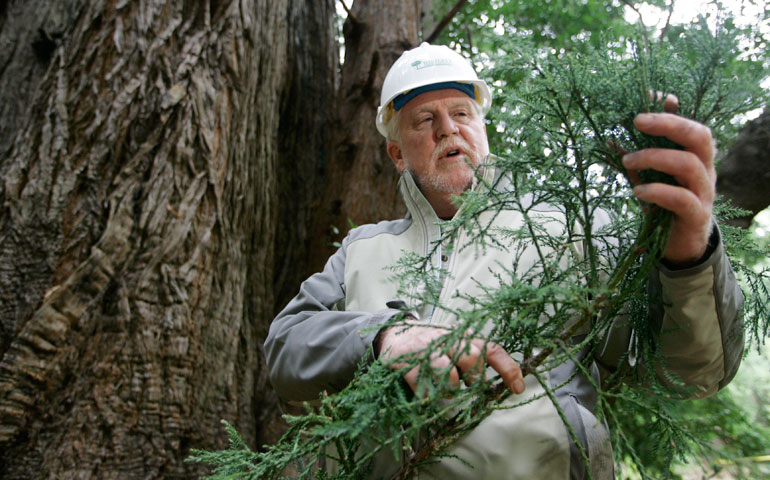
David Milarch looks over a cutting taken from a 1,000-year-old redwood tree in San Geronimo, Calif., Oct. 30, 2007. Climbers were collecting genetic samples to create clones of the trees to be used to re-establish redwood forests around California. (AP Photo/Eric Risberg)
 THE MAN WHO PLANTED TREES: LOST GROVES, CHAMPION TREES, AND AN URGENT PLAN TO SAVE THE PLANET
THE MAN WHO PLANTED TREES: LOST GROVES, CHAMPION TREES, AND AN URGENT PLAN TO SAVE THE PLANET
By Jim Robbins
Published by Spiegel & Grau, $25
As I sat in my wooded backyard on an eerily warm day in March, reading Jim Robbins’ Trees book, I felt an uncanny connection with the trees. Could they be like the ancient, giant yew in Ireland that Robbins describes as “portal[s] to divinity, a place where a seeker could go and have his or her soul lifted to the heavens”?
While Robbins’ work does not answer these supernatural questions, it does clearly explain the importance of trees in relation to two pressing issues of our time -- the increase of greenhouse gases in the atmosphere and forest fragmentation.
So much of what Robbins writes makes perfect sense. Being around trees makes individuals feel relaxed and healthy. Forests support human flourishing (and nourish all creatures for that matter) by filtering water and air, mitigating flooding, and possessing medicinal properties. However, these benefits are not long to stay. As a result of habitat destruction and global warming, insects, disease and overuse are decimating our remaining trees. We are left with forest fragments. A shameful statistic: Ninety-five percent of California’s ancient redwoods are gone.
We all suffer from the effects of this loss: Beetles annihilated the trees on Robbins’ property in Helena, Mont. Unseasonable storms this past fall left me anxious about the future of the beautiful trees outside my window.
In an effort to shed more light on this ecological crisis, Robbins weaves throughout the book the life story of one David Milarch. Milarch is a man whose “spiritual” claims do tend to test credibility. A Michigan native who grew up in a strict household, Milarch spent his young adulthood arm- and knuckle-wrestling, and working as a shade tree farmer. As his alcohol consumption threatened his family life, Milarch quit “cold turkey.” That left him gravely ill, and he claims he had a near-death experience. He returned from the “other side,” with a renewed sense of purpose, inspired to clone trees. (His spiritual journey to save the planet did not end with the white light, as he continues to receive guidance from “archangels” and “spirit guides” who nudge him along in his journey to reforest the world.)
While talk of near-death experiences invites skepticism and mockery, the notion of cloning also triggers questions and resistance. This is where Robbins’ professional background pays off for the reader. Robbins, a regular contributor to The New York Times science section, disabuses the reader of an easy and one-dimensional interpretation of tree cloning. Cloning trees -- aside from financial gains -- may be humanity’s only hope for combating this ecological meltdown we have created. Forests are our best weapon against the climate change that results from carbon dioxide and other gases.
Given current ecological degradation, and plant and animal species extinctions, we cannot hold onto simplistic ideas about preserving the planet. With climate change, the boundaries between what is natural and what is unnatural have broken down. Cloned trees might not be technically “natural,” or the strongest specimens, but Milarch and others hope that the clone’s offspring will offer the best chance for a healthy future.
In this accessible read -- though I would have appreciated a more elaborate and personal narrative -- Robbins’ measured prose is a good match for Milarch’s spiritual claims. Were Robbins more dramatic, he might lose credibility. Milarch’s “white light” and claims of trees communicating barely clings to the fringe of mainstream scientific research. Robbins allows the reader to make his or her own emotional connections. These personal stories have the capacity to foster a more rigorous commitment to the environment.
Robbins is right. Instead of taking from our forests, we need to study them. “It’s unforgivable,” he says, “how little we know about them.” The messianic work of Milarch, Robbins and others is a welcome step in transforming our understanding of the forest and our place in it.
[Michele Saracino is an associate professor of religious studies at Manhattan College in Riverdale, N.Y.]



